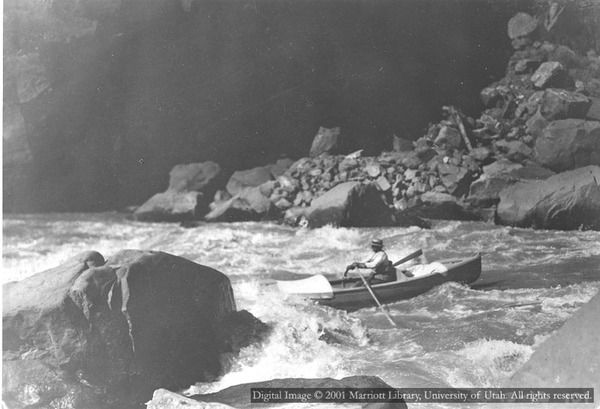Dublin Core
Title
Description
In September 1909, Julius Stone, a financier from Ohio, hired Utah adventurer Nathaniel Galloway to take him on a boat trip down the Green and Colorado Rivers. This is a time when navigating the steep and isolated canyons of Western rivers was an arduous necessity for scientists and geographers. But Stone and Galloway’s river trip was the first taken for the simple pleasure of boating and signaled an emerging interest in the idea of experiencing remote landscapes just for fun.
Inspired by the journeys taken by John Wesley Powell down these same rivers, Stone was passionate about the rugged outdoors. Galloway was a prospector and trapper from Vernal, Utah known for his experience on the Yampa and Green Rivers. Galloway guided the trip and Stone funded it, including the construction of boats built to Galloway’s new design. These flat-bottomed boats were rowed facing forward, so the oarsman had better control of the vessel and could see – and maneuver through – potential obstacles. Previous boat designs had oarsmen rowing with their backs downstream, resulting in frequent flips.
Galloway, Stone, and a small group of men set off in four boats from Green River, Wyoming. Although the trip was taken for leisure, it was not without trials. The men were relatively inexperienced and had to portage their boats and cargo around unmanageable rapids. Only Galloway effectively navigated the rushing waters, rowing into the current rather than trying to overpower it. Still, the men were awestruck by their impressive surroundings and devoted themselves to enjoying the beauty and magnificence of the river. Cutting through canyons, catching fish, and exploring remote scenery left a lasting impression on the group.
The Galloway-Stone Expedition ended five weeks later in Needles, California. The pleasure trip foreshadowed the popularity that river running would enjoy in the twentieth century, and the impact it would have on Utah’s economy. Tourists with money paid to appreciate the natural beauty of rivers. By the late 1920s commercially-operated tours were operating out of Vernal – and Galloway’s boat design was the preferred choice for river guides well into the 1950s.
Creator
Source
_______________
See Outdoor Industry Association Utah Report; Barry Swackhamer, “Julius Stone,” Historical Marker Database, accessed May 2021; Barry Swackhamer, “Nathaniel Galloway - 1890's,” Historical Marker Database, accessed May 2021; Brook Sutton, “Whitewater Pioneer Nathaniel Galloway,” Adventure Journal, last modified June 18, 2015; “Galloway Stone Expedition," National Park Service, accessed May 2021; “Go through Grand Canyon in Canoe,” Salt Lake Herald-Republican, July 2, 1910; Rafting America. “Early History of Commercial River Running and White Water Rafting," accessed May 2021; “Through the Grand Canyon,” Vernal Express, September 3, 1909; “Travels through Perils of Death,” Ogden Morning Examiner, January 2, 1910; “Voyage through Grand Canyon of the Colorado,” Vernal Express, August 13, 1909.

